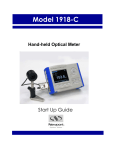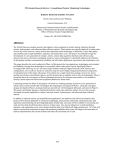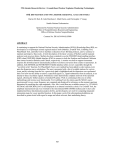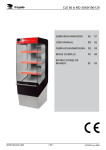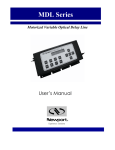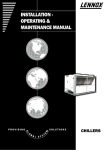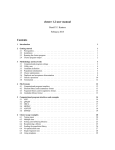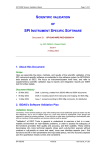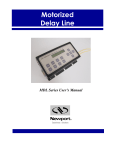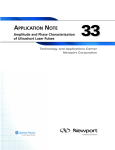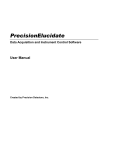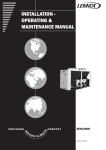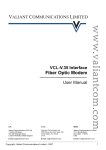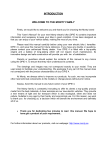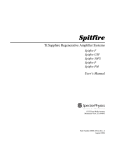Download PulseScout Autocorrelator
Transcript
PulseScout Autocorrelator PScout Series User’s Manual ii Preface Warranty Newport Corporation warrants that this product will be free from defects in material and workmanship and will comply with Newport’s published specifications at the time of sale for a period of one year from date of shipment. If found to be defective during the warranty period, the product will either be repaired or replaced at Newport's option. To exercise this warranty, write or call your local Newport office or representative, or contact Newport headquarters in Irvine, California. You will be given prompt assistance and return instructions. Send the product, freight prepaid, to the indicated service facility. Repairs will be made and the instrument returned freight prepaid. Repaired products are warranted for the remainder of the original warranty period or 90 days, whichever is longer. Limitation of Warranty The above warranties do not apply to products which have been repaired or modified without Newport’s written approval, or products subjected to unusual physical, thermal or electrical stress, improper installation, misuse, abuse, accident or negligence in use, storage, transportation or handling. This warranty also does not apply to fuses, batteries, or damage from battery leakage. This warranty is in lieu of all other warranties, expressed or implied, including any implied warranty of merchantability or fitness for a particular use. Newport Corporation shall not be liable for any indirect, special, or consequential damages resulting from the purchase or use of its products. First printing 2007 © 2007 by Newport Corporation. All rights reserved. No part of this manual may be reproduced or copied without the prior written approval of Newport Corporation. This manual has been provided for information only and product specifications are subject to change without notice. Any change will be reflected in future printings. Newport Corporation 1791 Deere Avenue Irvine, CA, 92606 USA P/N 90002247 Rev. A Preface iii EU Declaration of Conformity We declare that the accompanying product, identified with the mark, complies with requirements of the Electromagnetic Compatibility Directive, 89/336/EEC and the Low Voltage Directive 73/23/EEC. Model Number: PScout Series Autocorrelator and all options Year mark affixed: 2007 Type of Equipment: Electrical equipment for measurement, control and laboratory use Standards Applied: Compliance was demonstrated to the following standards to the extent applicable: EN 50082-1 Electromagnetic compatibility - Generic immunity standard Part 1: Residential, commercial and light industry EN 55011 Radio Frequency Disturbance - Industrial, scientific and medical (ISM) radio-frequency equipment - Radio disturbance characteristics - Limits and methods of measurement (IEC CISPR/B/269/CDV) EN 61010-1:2001, 2nd Edition “Safety requirements for electrical equipment for measurement, control and laboratory use” Bruno Rety Group Director of PPT Instrument and Motion Europe Micro-Controle Division of Newport Corporation Zone Industrielle 45340 Beaune-la-Rolande, France Dan Dunahay Director of Quality Systems Newport Corporation 1791 Deere Avenue Irvine, Ca. 92606, USA iv Preface Technical Support Contacts North America & Asia Europe Newport Corporation Service Dept. Newport/MICRO-CONTROLE S.A. 1791 Deere Ave. Irvine, CA 92606 Zone Industrielle Telephone: (949) 253-1694 45340 Beaune la Rolande, FRANCE Telephone: (800) 222-6440 x31694 Telephone: (33) 02 38 40 51 56 Asia Newport Opto-Electronics Technologies 253 Aidu Road, Bld #3, Flr 3, Sec C, Shanghai 200131, China Telephone: +86-21-5046 2300 Fax: +86-21-5046 2323 Newport Corporation Calling Procedure If there are any defects in material or workmanship or a failure to meet specifications, promptly notify Newport's Returns Department by calling 1-800-222-6440 or by visiting our website at www.newport.com/returns within the warranty period to obtain a Return Material Authorization Number (RMA#). Return the product to Newport Corporation, freight prepaid, clearly marked with the RMA# and we will either repair or replace it at our discretion. Newport is not responsible for damage occurring in transit and is not obligated to accept products returned without an RMA#. E-mail: [email protected] When calling Newport Corporation, please provide the customer care representative with the following information: • • • Your Contact Information Serial number or original order number Description of problem (i.e., hardware or software) To help our Technical Support Representatives diagnose your problem, please note the following conditions: • • • • Is the system used for manufacturing or research and development? • Can you identify anything that was different before this problem occurred? What was the state of the system right before the problem? Have you seen this problem before? If so, how often? Can the system continue to operate with this problem? Or is the system nonoperational? Preface v Table of Contents Warranty................................................................................................. ii EU Declaration of Conformity.............................................................. iii Technical Support Contacts .................................................................. iv Table of Contents ....................................................................................v 1 General Information 1.1 1.2 Introduction ...................................................................................1 Optical Assembly ..........................................................................5 1.2.1 Overview ...........................................................................5 1.2.2 Time Delay ........................................................................5 1.2.3 Mixing Crystal...................................................................5 1.2.4 Signal Detection ................................................................6 2 Specifications and Models 2.1 2.2 4.2 4.3 4.4 4.5 4.6 9 Menu Structure Overview .............................................................9 Control Menus .............................................................................11 3.2.1 Main Menu ......................................................................11 3.2.2 Correlator Submenus .......................................................12 3.2.3 Other Submenus ..............................................................17 4 Installation 4.1 7 Specifications ................................................................................7 Standard PScout Series Products...................................................8 3 Menu Structure 3.1 3.2 1 21 Detector and Crystal Installation.................................................21 4.1.1 Crystal Exchange.............................................................22 4.1.2 Detector Exchange...........................................................23 Interconnect Cables .....................................................................24 Input Alignment...........................................................................24 4.3.1 Baseplate Attachment......................................................24 4.3.2 Input Laser Beam Alignment ..........................................25 Collinear Autcorrelation..............................................................26 Finding the Autocorrelation Trace ..............................................26 Non-Collinear Autocorrelation....................................................27 vi Preface 5 Operation 5.1 5.2 5.3 5.4 5.5 5.6 Basic Operation ...........................................................................29 Scan Range Variation ..................................................................29 ZERO - Scan ................................................................................29 Low Pass Filter ............................................................................30 Interference Modulation ..............................................................30 Calculation of the ACF Half Width.............................................30 6 Troubleshooting 6.1 6.2 6.3 29 33 Rotation of Plane of Polarization ................................................33 Fundamental Overload ................................................................34 Common Errors ...........................................................................34 6.3.1 No SHG Signal ................................................................34 6.3.2 Input Power Too Small....................................................35 6.3.3 No Clear ACF..................................................................35 7 Safety 37 8 Factory Service Information 39 8.1 Service Form ...............................................................................39 1 General Information 1.1 Introduction The PulseScout autocorrelator consists of two components, the optics module shown in fig. 1 and the control electronics shown in fig. 2a and fig. 2b. The optics module contains a Michelson-interferometer, the delay unit, the interaction unit (SHG unit) and the detector head. The control electronics contain the necessary drivers and amplifiers, the display, and the power supply. Fig. 1 Optics Module 1 2 General Information The front panel of the control unit is shown in fig. 2a. There is a power switch and the push buttons for controlling: - the cursors < / CURSOR / > - the phase matching angle TUNING + / - the scan ranges SCAN RANGE + / The front panel also includes a MAIN and RETURN buttons for navigating the menu tree. MAIN takes you to the Main Menu, while RETURN takes you back one level in the Menu Structure. Additionally, includes (6) soft keys at the right edge of the display. The function of these keys depends on what menu you are in. Please refer to Chapter 3 for menu details. A GAIN tuning knob is located in the lower right corner of the front panel. Fig. 2a Control Electronics Front Panel General Information Fig. 2b 3 Control Electronics Rear Panel At the rear panel of the control electronics is located the main input power connector, the connector for the optics module (DB25), an RS232 serial interface (DB9), optional spectrometer (DB15), and the BNC connectors Trigger Input, Delay and AC Intensity. 4 General Information In fig. 3 the principal optical layout and the main electrical units are shown schematically. IM - Input Mirror IA - Input Aperture CW - Control Window BS - Beam Splitter FM - Focus Mirror C - Ultrathin SHG-Crystal (100/40 µm) A - Aperture Fi - Filter Det - Detector module Exchangeable detector module DET Fig. 3 Optical Layout Scheme General Information 5 1.2 Optical Assembly 1.2.1 Overview The optical beam path can be traced in fig. 3. Entering the optical assembly at the input aperture, the laser pulse is divided into two parts at the beam splitter. Each part traverses an interferometer arm containing a retroreflector. One of the retroreflectors is mounted on a special linear translation stage that can change the length of one interferometer arm in a continuous fashion. The two replica pulses then are recombined by the beam splitter, focused by a mirror, and overlapped in a nonlinear optical crystal. Light generated in the nonlinear crystal is then detected by a filtered photomultiplier (PMT) tube or photodiode. A portion of the back-reflected beams can be seen on the window next to the input aperture and are used for alignment of the beam into the autocorrelator. 1.2.2 Time Delay The time delay for generation of the autocorrelation trace is introduced by movement of a retroreflector mounted on a linear delay stage. Whenever the instrument is turned on, the delay stage will be oscillating at its resonant frequency of approximately 10 Hz. A voltage, proportional to the scaled position of the delay stage, is available at the “X” BNC connector at the rear panel of the electronic controller. 1.2.3 Mixing Crystal When tilted to the proper angle, a small amount of frequency doubled light is generated in the nonlinear crystal. In collinear geometry, the two replica pulses follow the same beam path and generate second harmonic light whether or not they overlap temporally. The intensity contrast between exactly overlapped pulses and pulses with no overlap is 3:1. In non-collinear geometry, only the second harmonic light produced by temporal overlap is detected. Hence, the contrast between exactly overlapped pulses and pulses with no overlap is infinite. Normally, the nonlinear crystal is inaccessible because it is slightly hygroscopic and can become fogged by high humidity. However, should the crystal need to be cleaned or exchanged, it can be accessed by removal of the upper cover of the optical assembly. 6 General Information 1.2.4 Signal Detection Second harmonic light, generated in the mixing crystal is detected by a photomultiplier tube or photodiode, which has been filtered to block transmission of light at the wavelength of the laser. The photo detector converts light intensity into an electronic signal. This signal is then electronically amplified and filtered, and is available at the “Y” BNC connector at the rear panel of the electronic controller. 2 Specifications and Models 2.1 Specifications Optical parameters: Max. scan range: 15 ps Resolution: <1 fs Scan frequency (approx.): 20 Hz Linearity distortions: <1% Input polarization: E horizontal (E vertical with polarization rotator) Standard Wavelength Range: 700-1100 nm Optional Wavelength Ranges: 420-550, 520-750, or 1000-1600 nm (1) < 10-4 W2 (PAV x PPEAK) PMT Detector Sensitivity : Photodiode Detector Sensitivity(1): 1W2 (PAV x PPEAK) Input beam height adjustment: 75 - 115 mm Electrical parameters: Input Power: Analog Outputs: Serial Interface: Trigger input: Dimensions (L x W x H): 95-264 VAC, 50/60 Hz 0-10 VDC RS232 5 V / 470 Ω Optical Unit: Control Electronics: Alignment Base (max.) 104 x 141 x 111 mm 292 x 280 x 186 mm 62 x 148 x 132 mm PPEAK x Tau = PAV x f_rep Tau = Pulse duration f_rep = Repetition rate 7 8 Specifications and Models 2.2 Standard PScout Series Products Below is Newport’s standard PScout Series offering. configurations are available by contacting Newport. Other custom Autocorrelators: PSCOUT HR PulseScout Autocorrelator, 50-3500fs, 700-1100nm, PMT PSCOUT LR PulseScout Autocorrelator, 50-3500fs, 700-1100nm, Photodiode PSCOUTSP HR PulseScout Autocorrelator, 20-3500fs, 700-1100nm, PMT PSCOUTSP LR PulseScout Autocorrelator, 20-3500fs, 700-1100nm, Photodiode PulseScout Upgrades and Accessories: PSCOUTUPG-BLUE1 Blue PMT Detector Module, 420-550nm PSCOUTUPG-BLUE2 Blue PD Detector Module, 420-550nm PSCOUTUPG-RED1 Red PMT Detector Module, 520-750nm PSCOUTUPG-RED2 Red PD Detector Module, 520-750nm PSCOUTUPG-HR NIR PMT Detector Module, 700-1100nm PSCOUTUPG-LR NIR PD Detector Module, 700-1100nm PSCOUTUPG-IR1 IR PMT Detector Module, 1000-1600nm PSCOUTUPG-IR2 IR PD Detector Module, 1000-1600nm PSCOUTUPG-SP PSCOUT Short Pulse Conversion Kit, 20fs PSPECNIR CCD Spectrometer, 700-1100nm PSPECVIS CCD Spectrometer, 300-700nm PSCOUT IEEE PulseScout IEEE Inferface PSCOUT USB PulseScout USB Interface PSCOUT WINDOWS PulseScout Windows Control Software (RS232) PSCOUT LABVIEW PulseScout Labview Driver (RS232) 3 Menu Structure 3.1 Menu Structure Overview The scan range SCAN RANGE +/-, the gain GAIN, the phase matching angle TUNING +/-, and the cursors < / CURSOR / > are controlled directly with the corresponding elements on the front panel (see fig. 2). The TRIGGER input (BNC connector) is used to apply the trigger signal from the laser necessary for an operation in the sampling mode. All other functions are menu-controlled. Fig. 4 shows an overview of the whole menu structure which is controlled by 6 soft keys at the right side of the display. Framed texts indicate active commands, texts without frames are for information only. The MAIN and RETURN buttons are used to navigate back from the current menu. In chapter 3.2 the menus, their functions and their handling are described in detail. 9 10 Menu Structure Fig. 4 Menu Structure Menu Structure 3.2 11 Control Menus After switching on and passing the initial routine the autocorrelator starts with the last set of measuring parameters and the main menu (fig. 4) with the actual detector signal being displayed. 3.2.1 Main Menu With the corresponding keys the correlator menu can be activated, the measurement can be stopped and different filter values for the AC signal channel can be selected. At the lower right corner of the display the actual parameters are shown: - Scan range, - Data acquisition mode, - Correlator sensitivity, - Average number, - Delay resolution, - Crystal tuning angle. If activated, the measured data ACF half width (FWHM) is displayed on top of the display. 12 Menu Structure Fig. 5 Main Menu 3.2.2 Correlator Submenus 3.2.2.1 Correlator Basic Menu By pressing the corresponding key one out of 5 submenus can be selected: - SAVE/CALL - Saving the current ACF or displaying saved ACF, while stopping the measurement, - SCANNER OFFSET - Control of interferometer Zero position (peak centering) - SENSITIVITY - Control of signal sensitivity, - ACQUISITION - Control of data acquisition, - DISPLAY MENU - Control of data display. Menu Structure 13 Fig. 6 Correlator Basic Menu 3.2.2.2 Correlator Save/Call Menu The controller features two memory places for ACF traces. With the Save/Call function the ACF Memory can be controlled. SAVE M1 / SAVE M2 saves the current ACF to memory M1/M2. CALL M1 / CALL M2displays the saved ACF of M1 / M2, while measurement is stopped. Fig 7 Correlator Save/Call Menu 14 Menu Structure 3.2.2.3 Correlator Sensitivity With the SENSITIVITY-function the signal amplification can be varied in addition to the GAIN-function. By pressing the + or - key the sensitivity is increased or decreased, respectively, by a factor of 3 in the range of 1 to 30. The OFFSET parameter controls an offset voltage to compensate dark current and other background signal components. It is stored separately for each sensitivity level. Please note that the offset parameter is changed only after releasing the button. Block the beam to set this parameter and make sure that the signal level is not below zero (check with scope at the analog y-output) or set slightly above lower edge of display. Fig. 8 Correlator Sensitivity 3.2.2.4 Data Acquisition Menu With the ACQUIRE MENU one can control: - Measuring modes (untriggered for high repetition rates, triggered for repetition rates < 10 kHz, envelope function for fringe resolved ACF, - Delay resolution (for a reduction of measuring time at low repetition rates) in Trigger and Fringes mode only - Signal averaging (for noise suppression). - Signal display smoothing for smoothing structured functions The measuring mode is selected with the FREE RUN >>> TRIGG key. In the untriggered mode (FREE RUN) the ACF data are measured continuously with the maximum acquisition rate and displayed and refreshed immediately. Menu Structure 15 In the triggered mode (TRIGGER) the delay and signal values are measured, digitized and saved only synchronously to an electrical trigger pulse from the measured laser applied at the trigger input. These pairs of measured data are superposed until a complete ACF is displayed. Caution, there is no ACF measurement without trigger pulse! The FRINGES-mode is a special function to display fringe resolved ACFs. While acquiring with maximum rate, this mode detects the maximum and minimum AC signal value of each delay channel to display the envelope of a sinusoidal modulated collinear ACF. For tuning the phase matching in this mode, it is necessary to switch to zero scan. Fig. 9 Data Acquisition 3.2.2.5 ACF Resolution With the ACF RESOL-function the delay resolution can be reduced for a faster, but more inaccurate measurement in the trigger mode. By pressing the „+“ or „-“ keys the resolution can be increased or reduced by a factor of 2 in the range of 256 to 32. 16 Menu Structure Fig. 10 ACF Resolution 3.2.2.6 ACF Averaging With the AVER-function the ACF can be averaged over n cycles. The displayed number n is the inverse weight, the actual measured signal value influences the displayed ACF with. The response time of the displayed ACF to variations is decreasing correspondingly. The average number is increased or decreased by a factor of 2 by pressing + or - key. Fig. 11 ACF Averaging Menu Structure 3.2.3 17 Other Submenus 3.2.3.1 Display Menu The DISPLAY MENU is used for controlling the displayed functions and parameters. With this the parameter calculation can be switched on or off and a bargraph menu can be selected. This menu lets you control the data transfer rate of the serial interface, and control the display brightness as well. Fig. 12 Display Menu 3.2.3.2 Bargraph Menu In the BARGRAPH MENU an analog bargraph displaying the actual ACF half width is switched on and off. 18 Menu Structure Fig. 13 Bargraph Menu 3.2.3.3 Cursor Basic Menu The CURSOR MENU, which is activated at any time by a separate CURSOR key below the display, controls the different cursors. These cursors allow manual measurements at the ACF alternatively to the automatic FWHMreadout. CURSOR MENU ACF EXIT Fig. 14 Cursor Basic Menu Menu Structure 19 3.2.3.4 Cursor Control Menu After the activation of the cursors ACF ∆τ 3 horizontal and 2 vertical green lines are displayed with one of them marked by higher intensity. This one is the cursor which can be moved with the CURSOR < / >-keys below the display. By pressing the corresponding keys HOR 1/2 and VERT 1/2, the active cursor can be changed. The third horizontal line in the middle shows the half amplitude between the lower and the upper horizontal cursors. When they are set to the peak and the background level of the ACF the crossings of the half amplitude cursor with the corresponding function give its actual half width which can then be measured with the vertical cursors. At the top of the display the actual positions of the vertical cursors are displayed. Fig. 15 Control of Cursors in ACF 4 Installation If the system has been shipped during the cold winter months, please allow time for the instrument to warm slowly to the temperature of the laboratory. 4.1 Detector and Crystal Installation An optics set consists of a crystal and a detector. For shipment the crystal is removed and needs to be installed in the optics unit. The detector unit will be installed when you receive the Pulse Scout. A detector unit has already been pre-installed. If there are several detectors the detector for the laser wavelength should be installed. Fig. 16 Crystal and Detector Access 21 22 Installation 4.1.1 Crystal Exchange Before exchanging the crystal make sure that there is no laser light passing through the optics unit. 1) In order to have the handhold of the crystal holder easily accessible tune crystal angle to about 500. 2) Switch off control electronics, so that the scanner is motionless and the detector is inactive. 3) Open crystal exchange lid. Fig. 17 shows the optics unit with the crystal exchange lid removed and crystal installed. The crystal is fixed to the crystal retainer by a magnet. Fig. 17 Open crystal container with Fig. 17 Close up of crystal installed crystal 4) Remove the crystal by slightly tilting the handhold of the crystal holder (see arrow in Fig. 17) and pulling it out. Fig. 17 Crystal Compartment with Crystal Installed Fig. 18 Crystal Assembly Installation 23 Fig. 19 Crystal Compartment with Crystal Removed 4.1.2 Detector Exchange Before exchanging the detector unit make sure that there is no laser light passing through the optics unit. 1) Switch off control electronics and disconnect the cable to the optics unit. 2) Unfasten the two fixing screws, pull out detector unit and replace with the detector required for your actual laser wavelength to be measured. 3) Fasten fixing screws. 4) Connect controller to optics unit and switch on. The installed type of detector (PMT or PD) is recognized automatically. Fig. 20 Detector Module Exchange 24 Installation 4.2 Interconnect Cables Interconnect the optical unit and control electronics with the 25-pin cable provided. Connect the electronics to the main power source, using the AC adapter. If using the optional spectrometer, connect with the 15-pin cable provided with the spectrometer. 4.3 Input Alignment 4.3.1 Baseplate Attachment By adjusting the columns the beam height can be varuied. They can be positioned either above or below the base plate of the autocorrelator. Caution: The columns and the screws function as a unit: Never unscrew the columns completely, as they are connected by a spring which will come loose if the columns are not tightenend to the screw! In order to change the position of the columns, the whole leg (columns and screw) has to be untightened. This can be achieved by using the foot clamps as a wrench. Attach the baseplate to the optical assembly, level the unit, and lock down the adjustment feet. 1. Screw the two front feet into the base plate as shown in Figure 16. 2. Place the optical unit onto the baseplate, aligning the hole underneath the control window with the pin in the baseplate. 3. Using the M6 screw provided, attach the optical unit to the base plate. 4. Level the base plate to the appropriate height. Installation 25 Fig. 16 Adjustment Feet 4.3.2 Input Laser Beam Alignment Direct a portion of the laser beam towards the autocorrelator, using an appropriate optical element (glass plate, mirror, etc.) mounted in a good mirror mount. The beam should enter through the input aperture of the autocorrelator nearly perpendicular to the unit. The input beam must have horizontal polarization, in order to satisfy the phasematch condition of the nonlinear crystal, and have low angular divergence. Bring the back reflection of the beam to match the cross wires at the control window by alignment of the optical unit. If there are two back reflections (noncollinear interaction) they can be united by turning the screw (see fig. 1). 26 Installation Twisting the optical assembly in the horizontal plane will move the back reflection in the horizontal plane and tilting the optical assembly up or down with the third leg will move the back reflection up or down. Once the optical assembly is grossly aligned, it should be clamped to the table. Final adjustments can be made by adjustment of the mirror mount that holds the sampling element. For measurement of the AC signal tilt back the variable aperture. 4.4 Collinear Autcorrelation Although it is often preferred to operate the autocorrelator in the backgroundfree, or non-collinear mode, it is sometimes easier to find an autocorrelation signal in the collinear mode. If one has trouble finding the autocorrelation trace, then turn the screw (see fig. 1) all the way in for collinear operation. In collinear mode, you are guaranteed to see a signal from the autocorrelator if the crystal is aligned at the proper angle, even if the two replica beams do not overlap temporally or spatially. Hence, due to the fewer variables involved, it is best to use this collinear configuration to begin with the optimization of the autocorrelation trace. 4.5 Finding the Autocorrelation Trace - Switch the autocorrelator ON. - After an initialization period, the unit is ready for measurement. - At first you will see a flat horizontal line over the whole screen. Slowly increase the „GAIN“ until either a clear signal or noise is observed. If the autocorrelator is responding to room lights, dim the lights or block off the source of external light to the autocorrelator. - Rotate the crystal by using the “Turning” knobs to find the optimal angle. An optimally aligned crystal is characterized by a clear, angle dependent signal maximum. The actual angle value for the crystal is shown in the lower right corner of the display. If a limit is reached such that the numbered displayed is no longer changing, reverse the drive direction. Attention: Many laser sources have a small portion of second harmonic light coincident with the fundamental laser pulse, and this small amount of light may swamp the second harmonic signal that is generated by the thin crystal inside the autocorrelator. To avoid this insert a long pass filter into the laser beam such that the fundamental wavelength is transmitted and wavelengths in the vicinity of the second harmonic are blocked. Installation 27 - As a check for the real autocorrelation signal, block one of the beams of the Michelson-Interferometer inside the autocorrelator. This can be done by pushing the knobs on top of the autocorrelator. Blocking either beam individually will eliminate the signal originating from the interaction of the two beams. In addition, it will reduce the background away from the peak by 50%. - Optimize the peak and the peak-to-background ratio of the autocorrelation signal through adjustment of the crystal tilt, focus, scan range and filter. - If there is no angle dependent signal or no peak, check that there is no stray light from the laser beam by inserting a long pass filter into the beam. Additionally, go back and recheck the alignment so that there is a back reflection at the cross wires, that the input polarization is horizontal, and that the laser is mode-locked (see chapter 7.1 “Troubleshooting”) - If the autocorrelation signal goes off scale, decrease the „GAIN“ and/or decrease the laser input power (ND-filters, lower reflectivity of the coupling element etc.). 4.6 Non-Collinear Autocorrelation Set the instrument to the collinear autocorrelation mode. Gradually, move from the collinear configuration to the non-collinear configuration. By turning the “Beam Distance” screw(see fig. 1) a configuration between collinear and non-collinear can be chosen. The beam separation distance can be monitored directly at the control window. In the non-collinear case the second (movable) back reflection will be to the left side of the cross hairs. While changing the beam distance, make sure to optimize the focus adjustment, the sensitivity and the phase matching angle. 5 Operation 5.1 Basic Operation 1. Switch on the autocorrelator and wait for the instrument to finish its initialization regimen. 2. Check the alignment. 3. Read the autocorrelation trace. 4. Remember, if the wavelength is changed, the phase matching angle will need to be changed. In addition, the GAIN and focusing adjustment may require reoptimization. 5.2 Scan Range Variation Each scan range is measured by a delay sensor, stabilized and calibrated. The delay output is normalized to appr. 0 ... 10V amplitude. After switching to another scan range it takes some time (5 ... 30 s) to reach the new range. 5.3 ZERO - Scan The ZERO SCAN-function stops the delay at the zero position. At the display the signal values at different times are shown similar to an oscillograph. It is thereby possible to observe amplitude modulations and to align the autocorrelator to the maximum of the ACF. 29 30 Operation 5.4 Low Pass Filter This switchable filter suppresses high frequency noise of the detector or the interference fringes in the collinear case. For the measurement in triggered mode and of a fringe resolved ACF it is automatically switched off. 5.5 Interference Modulation If exactly aligned in the collinear case, the AF is superimposed by the interference fringes of the interferometer (sinusoidal modulation - fringe resolved ACF). They can either be averaged with the low pass filter (simple intensity ACF) or displayed with the FRINGES-mode, displaying the envelope of this function. This mode helps to check if the pulse is chirped. In the triggered mode where this filter is not active and in the ZERO SCAN the fringes simulate strong amplitude modulations, which make it difficult to align the optimal phase matching. Therefore it is recommended to increase the beam distance slightly to measure a collinear ACF without interferences. 5.6 Calculation of the ACF Half Width For the calculation of the ACF half width the background value is taken at the edge of the display. The difference of this value and the maximum is taken and halved. After that, the crossings of this amplitude value and the ACF right and left from the maximum are locked for. Their distance is the measured half width which is displayed at the top of the display. That´s why the ACF peak has to be zero at the edge of the display for measuring a correct value with this algorithm (if necessary change the scan range). After getting the ACF displayed one can measure the half width of the autocorrelation function. It is defined as FWHM (Full Width at Half Maximum) which means the width at the half intensity level between the maximum of AC peak and the baseline outside the peak (fig. ?). Most comfortable is the application of cursors, otherwise the oscilloscope grating can be used. Measure ACF width b and complete scan width B (maximum scan). Due to the automatic scan control the complete width B is defined by the actually selected scan range. Therefore the autocorrelation half width FWHM is calculated as: FWHM = b/B x Scanbereich. Operation 31 To get the real pulse duration one has to correct the AC-width with a form factor depending on pulse shape: τ = FWHM x F Fig 16 Calculation of ACF Half Width 6 Troubleshooting 6.1 Rotation of Plane of Polarization Usage of a Polarization Rotator (λ/2-plate) The effect of polarization rotation can be very wavelength sensitive depending on its type. Rotation by a Double 90°-Beam Steering Two mirrors mounted 45° to the input beam and steering it in different planes cause an effective wavelength-insensitive 90° rotation of the plane of polarization. Such a polarization rotator is included. 33 34 Troubleshooting Fig. 17 Polarization rotator 6.2 Fundamental Overload At very extreme wavelengths and input power levels the ACF can be superposed by a larger background from the fundamental wave in the collinear case. This can be avoided by using the non-collinear interaction or the use of special filters and detectors. 6.3 Common Errors 6.3.1 No SHG Signal Potential Causes: 1. Wrong polarization direction 2. Wrong alignment 3. No or too long input pulse Check: 1a. Check with polarization rotator. (see 7.2.) 1b. Introduce a polarization rotator in the input beam. 2. Check beam position at input aperture. 3. Check back reflection at control window. 4. Check FOCUS-position. 5. Check phase matching. 6. Check with an independent method. (fast photodiode, spectral width etc.) Troubleshooting 6.3.2 35 Input Power Too Small Potential Causes: 1. Delay-zero-position outside of scan range 2. Compare with sensitivity (see Specifications). Check: 1. Check at wider scan ranges, check the DELAY-position (see Specifications, offset setting) 6.3.3 No Clear ACF Potential Causes: Wrong scan range No or too long input pulses Check: Check at wider scan ranges Check with an independent method. (fast photodiode, spectral witdth…) 7 Safety For the application of lasers you have to pay attention to safety rules according to the used laser class! Incorrect handling and operation of lasers can be hazardous to your health! Prevent the Autocorrelator from humidity, because the SHG crystals are slightly hygroscopic and they are not mounted in housing because of dispersion. 37 8 Factory Service Information 8.1 Service Form Newport Corporation U.S.A. Office: 800-222-6440 FAX: 949/253-1479 Name_________________________________ Return Authorization # _________________________ (Please obtain RA# prior to return of item) Company ___________________________________________________________________________ Address ______________________________ Date _______________________________________ Country _______________________________ Phone Number _______________________________ P.O. Number ___________________________ FAX Number_________________________________ Item(s) Being Returned: Model # ______________________________ Serial # _____________________________________ Description __________________________________________________________________________ ___________________________________________________________________________________ ___________________________________________________________________________________ ___________________________________________________________________________________ ___________________________________________________________________________________ ___________________________________________________________________________________ Reason for return of goods (please list any specific problems): ___________________________________________________________________________________ ___________________________________________________________________________________ ___________________________________________________________________________________ ___________________________________________________________________________________ ___________________________________________________________________________________ ___________________________________________________________________________________ ___________________________________________________________________________________ ___________________________________________________________________________________ ___________________________________________________________________________________ 39 40 Factory Service Information Notes:______________________________________________________________________________ ___________________________________________________________________________________ ___________________________________________________________________________________ ___________________________________________________________________________________ ___________________________________________________________________________________ ___________________________________________________________________________________ ___________________________________________________________________________________ ___________________________________________________________________________________ ___________________________________________________________________________________ ___________________________________________________________________________________ ___________________________________________________________________________________ ___________________________________________________________________________________ ___________________________________________________________________________________ ___________________________________________________________________________________ ___________________________________________________________________________________ ___________________________________________________________________________________ ___________________________________________________________________________________ ___________________________________________________________________________________ ___________________________________________________________________________________ ___________________________________________________________________________________ ___________________________________________________________________________________ ___________________________________________________________________________________ ___________________________________________________________________________________ ___________________________________________________________________________________ ___________________________________________________________________________________ ___________________________________________________________________________________ ___________________________________________________________________________________ ___________________________________________________________________________________ ___________________________________________________________________________________ ___________________________________________________________________________________ ___________________________________________________________________________________ ___________________________________________________________________________________ ___________________________________________________________________________________ ___________________________________________________________________________________ ___________________________________________________________________________________ ___________________________________________________________________________________ ___________________________________________________________________________________















































